-
 Bitcoin
Bitcoin $114000
0.38% -
 Ethereum
Ethereum $3494
-0.29% -
 XRP
XRP $2.876
-1.80% -
 Tether USDt
Tether USDt $0.9999
0.02% -
 BNB
BNB $749.1
-0.45% -
 Solana
Solana $161.8
-1.23% -
 USDC
USDC $0.9998
0.00% -
 TRON
TRON $0.3249
-0.42% -
 Dogecoin
Dogecoin $0.1987
-0.05% -
 Cardano
Cardano $0.7247
1.90% -
 Hyperliquid
Hyperliquid $38.39
0.52% -
 Stellar
Stellar $0.3889
2.87% -
 Sui
Sui $3.459
1.66% -
 Chainlink
Chainlink $16.18
1.43% -
 Bitcoin Cash
Bitcoin Cash $540.8
1.19% -
 Hedera
Hedera $0.2449
3.79% -
 Ethena USDe
Ethena USDe $1.001
0.03% -
 Avalanche
Avalanche $21.41
-0.12% -
 Toncoin
Toncoin $3.699
4.73% -
 Litecoin
Litecoin $110.0
3.08% -
 UNUS SED LEO
UNUS SED LEO $8.964
0.05% -
 Shiba Inu
Shiba Inu $0.00001221
1.28% -
 Polkadot
Polkadot $3.608
1.91% -
 Uniswap
Uniswap $9.150
1.59% -
 Monero
Monero $297.7
0.78% -
 Dai
Dai $1.000
0.02% -
 Bitget Token
Bitget Token $4.319
0.78% -
 Pepe
Pepe $0.00001051
1.89% -
 Cronos
Cronos $0.1323
0.20% -
 Aave
Aave $257.8
1.36%
Which Bitcoin spot trading platform is the safest?
No single "safest" Bitcoin spot trading platform exists; security depends on factors like regulatory compliance, robust security protocols (including cold storage and MFA), insurance, reputation, and user-friendly design.
Mar 02, 2025 at 07:54 pm
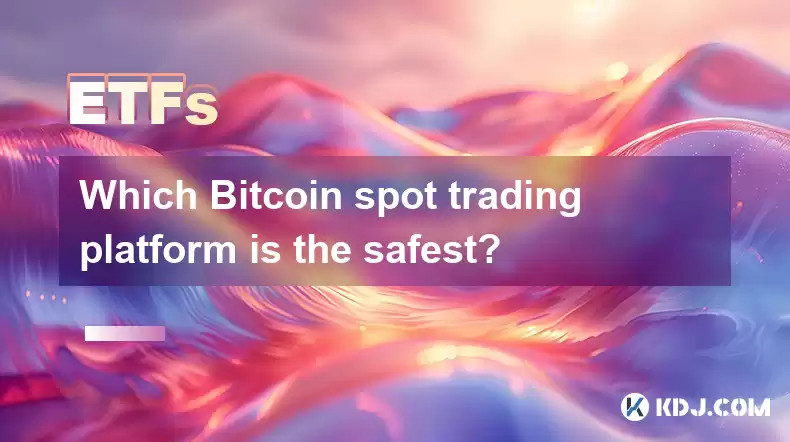
Which Bitcoin Spot Trading Platform is the safest?
Key Points:
This article explores the crucial question of safety when choosing a Bitcoin spot trading platform. It won't provide a definitive "safest" platform because safety is multifaceted and depends on individual needs and risk tolerance. Instead, we'll delve into key factors determining a platform's security and examine several reputable exchanges, highlighting their strengths and weaknesses regarding security measures. We will also address common security concerns and best practices for users to mitigate their risk. Finally, we will answer frequently asked questions regarding Bitcoin spot trading platform security.
Assessing the Safety of Bitcoin Spot Trading Platforms:
Choosing a secure Bitcoin spot trading platform involves careful consideration of various factors. There's no single "safest" platform, as the ideal choice depends on your specific needs and risk tolerance. However, several key aspects contribute significantly to a platform's overall security posture. Let's explore them:
- Regulatory Compliance and Licensing:
A crucial factor in assessing the safety of a Bitcoin spot trading platform is its regulatory compliance and licensing. Reputable platforms operate under the purview of established financial regulatory bodies, adhering to Know Your Customer (KYC) and Anti-Money Laundering (AML) regulations. These regulations aim to prevent illicit activities, such as money laundering and terrorist financing, and to ensure transparency within the cryptocurrency ecosystem. Platforms that comply with these regulations demonstrate a commitment to operating within a legal framework, reducing the risk of scams and fraudulent activities. The specific regulatory landscape varies depending on the jurisdiction, with some regions having stricter regulations than others. For instance, platforms operating in jurisdictions with robust regulatory frameworks, such as those in Europe or certain parts of the United States, often face more stringent requirements, leading to enhanced security measures. Conversely, platforms operating in less regulated jurisdictions may face fewer oversight requirements, potentially increasing the risk for users. Therefore, checking the regulatory compliance of a platform is essential before entrusting it with your funds. Look for evidence of registration with relevant financial authorities, and investigate the platform's history of compliance with regulations. A platform's transparency in disclosing its regulatory status is also crucial. Avoid platforms that are opaque about their regulatory standing, as this may indicate a lack of commitment to compliance. Finally, remember that regulatory compliance is not a guarantee of absolute security, but it significantly reduces the risk associated with unregulated entities. It demonstrates a commitment to operating responsibly and adhering to industry best practices.
- Security Protocols and Technology:
Beyond regulatory compliance, the security protocols and technology employed by a Bitcoin spot trading platform are paramount. Robust security measures are essential to protect user funds from theft and unauthorized access. These measures often include multi-factor authentication (MFA), which requires users to provide multiple forms of identification to access their accounts. MFA significantly enhances account security by adding an extra layer of protection beyond simple passwords. Many platforms also utilize advanced encryption techniques to protect user data and transactions, preventing unauthorized access and interception. Cold storage of the majority of cryptocurrency assets is a critical security feature. Cold storage refers to storing cryptocurrency offline, in offline wallets, significantly reducing the risk of hacking or theft. Platforms that employ cold storage for the bulk of their users' funds demonstrate a strong commitment to security. Regular security audits by independent cybersecurity firms are another vital aspect of a platform's security posture. These audits help identify vulnerabilities and weaknesses in the platform's systems, allowing for timely remediation and mitigation of risks. The frequency and transparency of these audits are important indicators of a platform's commitment to security. Furthermore, the platform's architecture should be designed with security in mind. Robust systems, redundancy, and disaster recovery plans are crucial to ensure the platform's resilience in the face of potential attacks or system failures. These measures, while often invisible to the average user, contribute significantly to the overall security of the platform. It is also important to examine the platform's approach to incident response. A well-defined and tested incident response plan is crucial to effectively handle any security breaches or incidents. A transparent and timely response to any security issues is indicative of a platform that prioritizes user security.
- Insurance and Compensation Schemes:
While not a guarantee against all losses, insurance and compensation schemes can provide an additional layer of protection for users. Some platforms offer insurance policies that cover losses resulting from security breaches or hacking incidents. These insurance policies can mitigate the financial impact on users in the event of such incidents. Furthermore, some platforms participate in compensation schemes that provide users with compensation for losses incurred due to platform failures or security vulnerabilities. These schemes typically involve a pool of funds that are used to compensate affected users. It's crucial to understand the terms and conditions of any insurance or compensation scheme offered by a platform, as they may have limitations and exclusions. The extent of coverage, the claims process, and the eligibility criteria should be carefully reviewed. Not all platforms offer insurance or participate in compensation schemes, so it's important to consider this factor when choosing a platform. The presence of such schemes can enhance user confidence and provide an additional layer of security. However, relying solely on insurance or compensation schemes is not advisable. Users should still adopt best practices for securing their accounts and protecting their funds.
- Reputation and Track Record:
A platform's reputation and track record are crucial indicators of its trustworthiness and security. A platform with a long-standing history of secure operations and a positive reputation within the cryptocurrency community is more likely to be a safer choice. Researching a platform's history, reading reviews from other users, and looking for any reports of security breaches or incidents can provide valuable insights into its security practices. Platforms with a history of security incidents or negative user reviews should be approached with caution. It's important to rely on multiple sources of information, avoiding biased reviews or opinions. A platform's transparency in addressing security issues and its commitment to resolving user concerns are also important factors to consider. A responsive and transparent platform is more likely to prioritize user security and take appropriate measures to address any issues that arise. A platform's engagement with the community and its responsiveness to security concerns can provide further insights into its commitment to security. Forums, social media, and other online communities can be valuable resources for gathering information about a platform's reputation and track record.
- User Experience and Security Features:
While seemingly less critical than core security infrastructure, the user experience and integrated security features significantly impact a platform's overall security. A well-designed, user-friendly interface can minimize human error, a major source of security vulnerabilities. Intuitive navigation and clear instructions for implementing security measures, such as two-factor authentication, reduce the likelihood of users making mistakes that compromise their accounts. Conversely, a poorly designed interface might lead to confusion and increase the risk of users falling prey to phishing scams or accidentally revealing sensitive information. The availability of advanced security features, such as withdrawal whitelisting, adds another layer of protection. Withdrawal whitelisting allows users to specify the addresses to which they can send their funds, preventing accidental or unauthorized transfers. Features like email and SMS alerts for suspicious activity provide users with real-time notifications of potential security threats, allowing for prompt action to mitigate any risks. Regular security updates and patches are crucial to address vulnerabilities and keep the platform's security infrastructure up-to-date. Platforms that actively update their systems demonstrate a proactive approach to security, reducing the likelihood of exploits and breaches. The platform's communication about security updates and its transparency in addressing any issues that arise also contributes to building trust and confidence.
FAQs:
- Q: What is a Bitcoin spot trading platform?
- A: A Bitcoin spot trading platform is an online exchange where users can buy and sell Bitcoin for fiat currency (like USD, EUR, etc.) or other cryptocurrencies at the current market price (the "spot" price).
- Q: Are all Bitcoin spot trading platforms equally safe?
- A: No, the safety of Bitcoin spot trading platforms varies significantly depending on the factors discussed above, such as regulatory compliance, security protocols, insurance, reputation, and user experience features.
- Q: How can I protect myself from scams when using a Bitcoin spot trading platform?
- A: Thoroughly research the platform before using it, verify its regulatory compliance, enable two-factor authentication, use strong and unique passwords, be wary of phishing attempts, and only download official apps from trusted sources. Never share your private keys or seed phrases with anyone.
- Q: What should I do if I suspect my Bitcoin spot trading platform has been compromised?
- A: Immediately contact the platform's customer support, change your passwords, and enable two-factor authentication if you haven't already. Monitor your account activity closely and consider reporting the incident to the appropriate authorities.
- Q: What is the role of cold storage in Bitcoin spot trading platform security?
- A: Cold storage is the practice of storing the majority of cryptocurrency assets offline, in secure offline wallets, making them inaccessible to hackers who might gain access to online systems. This significantly reduces the risk of theft.
- Q: How important are security audits for Bitcoin spot trading platforms?
- A: Independent security audits are crucial as they help identify vulnerabilities and weaknesses in a platform's systems, enabling the platform to address them before they can be exploited by malicious actors. The frequency and transparency of these audits are key indicators of a platform's commitment to security.
- Q: Can insurance fully protect me from losses on a Bitcoin spot trading platform?
- A: While insurance can provide an additional layer of protection, it doesn't guarantee against all losses. Terms and conditions vary, and some events might not be covered. It's important to review the details carefully. User diligence and security best practices remain crucial.
- Q: What is the significance of a platform's reputation and track record?
- A: A platform's reputation and track record are crucial indicators of its trustworthiness and security. Researching its history, reading user reviews, and looking for reports of security breaches can provide valuable insights. A positive track record and transparent communication about security issues build confidence.
- Q: How does user experience impact security?
- A: A well-designed, user-friendly interface minimizes human error, a major source of security vulnerabilities. Clear instructions for security measures and advanced features like withdrawal whitelisting contribute to improved security. A poorly designed platform can increase the risk of mistakes and scams.
Disclaimer:info@kdj.com
The information provided is not trading advice. kdj.com does not assume any responsibility for any investments made based on the information provided in this article. Cryptocurrencies are highly volatile and it is highly recommended that you invest with caution after thorough research!
If you believe that the content used on this website infringes your copyright, please contact us immediately (info@kdj.com) and we will delete it promptly.
- Altcoins Most Searched: Hedera (HBAR) and the ETF Hype
- 2025-08-03 20:50:16
- Arbitrage Adventures: Creditcoin, Kaspa, and Chasing Crypto Profits
- 2025-08-03 20:30:16
- Claude HIVE & Code Agents: Faster Coding Revolution?
- 2025-08-03 20:50:16
- Trump Media, Bitcoin, and Crypto: A Surprising Alliance in the Making?
- 2025-08-03 21:30:16
- Shiba Inu's Bullish Reversal Hopes Amid Market Uncertainty: A Deep Dive
- 2025-08-03 21:30:16
- Shiba Inu's Struggle, Mutuum Finance's Rise, and Key Support Levels: A Crypto Deep Dive
- 2025-08-03 20:55:16
Related knowledge
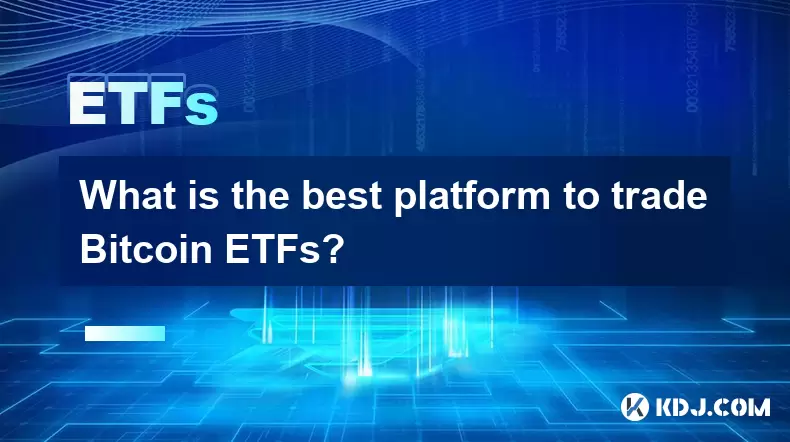
What is the best platform to trade Bitcoin ETFs?
Jul 23,2025 at 04:14am
Understanding Bitcoin ETFs and Their Role in TradingBitcoin Exchange-Traded Funds (ETFs) have gained significant traction among traditional and crypto...
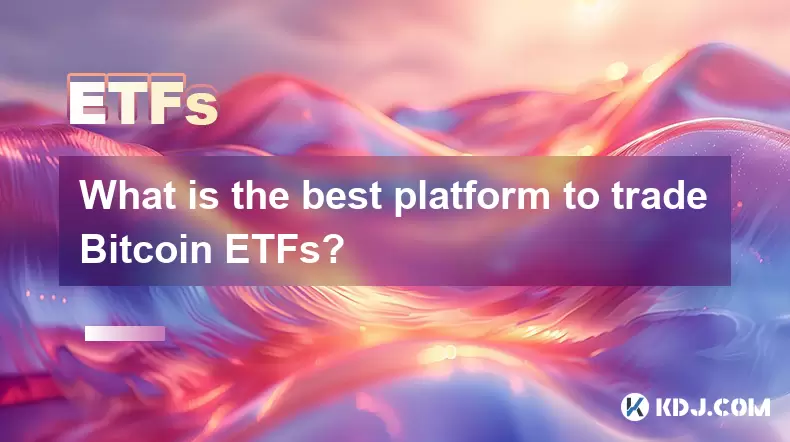
What is the best platform to trade Bitcoin ETFs?
Jul 17,2025 at 03:50pm
Understanding Bitcoin ETFs and Their Role in the MarketBitcoin Exchange-Traded Funds (ETFs) are investment vehicles that track the price of Bitcoin wi...

Will a Bitcoin ETF be available in my 401(k)?
Jul 17,2025 at 10:42pm
What is a Bitcoin ETF?A Bitcoin ETF (Exchange-Traded Fund) is an investment vehicle that tracks the price of Bitcoin without requiring investors to di...
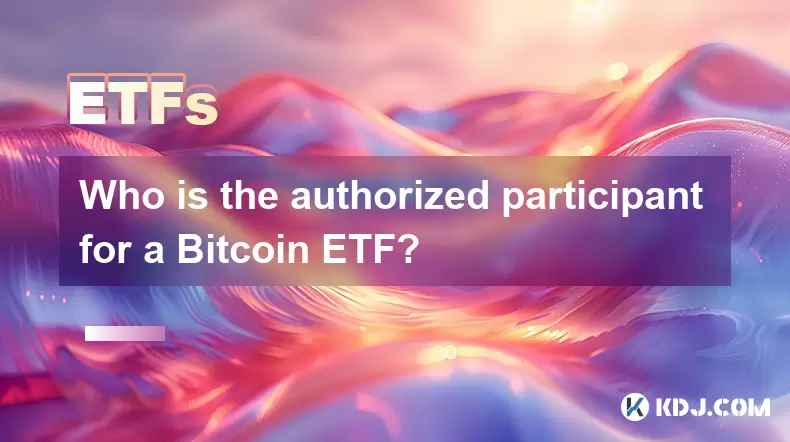
Who is the authorized participant for a Bitcoin ETF?
Jul 18,2025 at 12:42am
Understanding the Role of Authorized Participants in Bitcoin ETFsIn the context of Bitcoin Exchange-Traded Funds (ETFs), an authorized participant (AP...
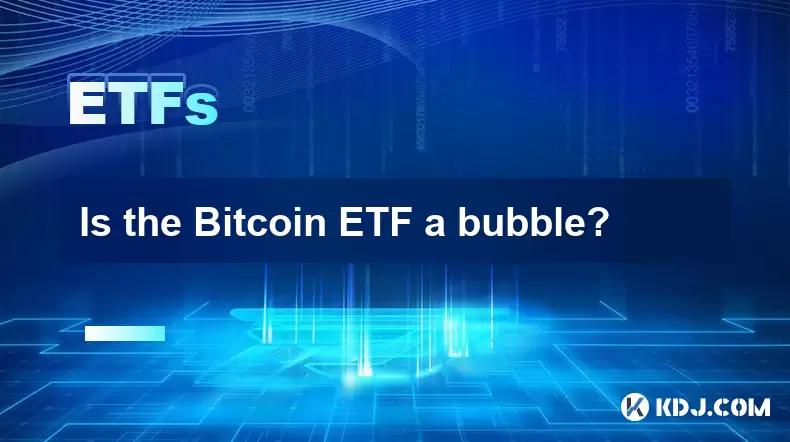
Is the Bitcoin ETF a bubble?
Jul 20,2025 at 06:57am
Understanding the Bitcoin ETF ConceptA Bitcoin Exchange-Traded Fund (ETF) is a financial product that aims to track the price of Bitcoin without requi...
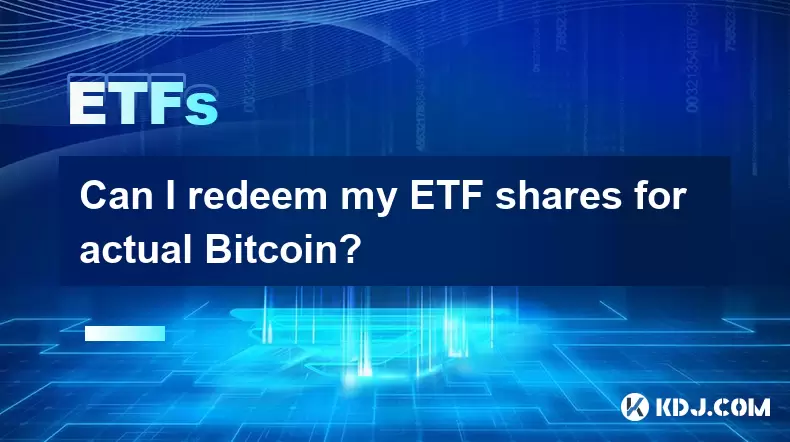
Can I redeem my ETF shares for actual Bitcoin?
Jul 17,2025 at 03:14pm
Understanding ETF Shares and Their Relation to BitcoinExchange-Traded Funds (ETFs) have become a popular investment vehicle for those looking to gain ...

What is the best platform to trade Bitcoin ETFs?
Jul 23,2025 at 04:14am
Understanding Bitcoin ETFs and Their Role in TradingBitcoin Exchange-Traded Funds (ETFs) have gained significant traction among traditional and crypto...

What is the best platform to trade Bitcoin ETFs?
Jul 17,2025 at 03:50pm
Understanding Bitcoin ETFs and Their Role in the MarketBitcoin Exchange-Traded Funds (ETFs) are investment vehicles that track the price of Bitcoin wi...

Will a Bitcoin ETF be available in my 401(k)?
Jul 17,2025 at 10:42pm
What is a Bitcoin ETF?A Bitcoin ETF (Exchange-Traded Fund) is an investment vehicle that tracks the price of Bitcoin without requiring investors to di...

Who is the authorized participant for a Bitcoin ETF?
Jul 18,2025 at 12:42am
Understanding the Role of Authorized Participants in Bitcoin ETFsIn the context of Bitcoin Exchange-Traded Funds (ETFs), an authorized participant (AP...

Is the Bitcoin ETF a bubble?
Jul 20,2025 at 06:57am
Understanding the Bitcoin ETF ConceptA Bitcoin Exchange-Traded Fund (ETF) is a financial product that aims to track the price of Bitcoin without requi...

Can I redeem my ETF shares for actual Bitcoin?
Jul 17,2025 at 03:14pm
Understanding ETF Shares and Their Relation to BitcoinExchange-Traded Funds (ETFs) have become a popular investment vehicle for those looking to gain ...
See all articles

























































































